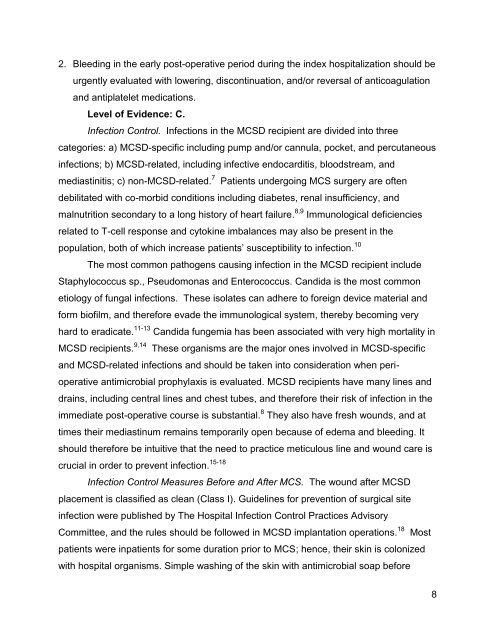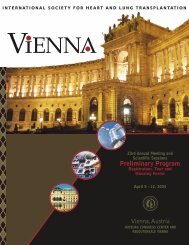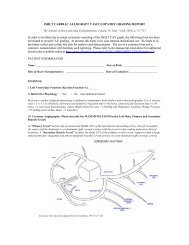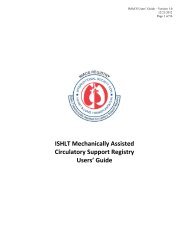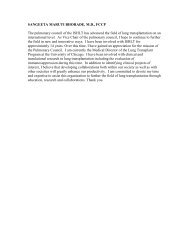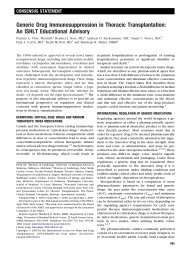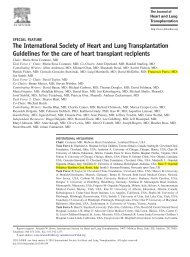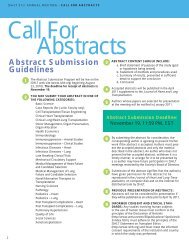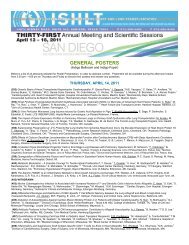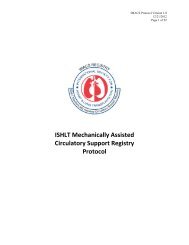Task Force 4: Inpatient Management of Patients with MCSD - The ...
Task Force 4: Inpatient Management of Patients with MCSD - The ...
Task Force 4: Inpatient Management of Patients with MCSD - The ...
Create successful ePaper yourself
Turn your PDF publications into a flip-book with our unique Google optimized e-Paper software.
2. Bleeding in the early post-operative period during the index hospitalization should be<br />
urgently evaluated <strong>with</strong> lowering, discontinuation, and/or reversal <strong>of</strong> anticoagulation<br />
and antiplatelet medications.<br />
Level <strong>of</strong> Evidence: C.<br />
Infection Control. Infections in the <strong>MCSD</strong> recipient are divided into three<br />
categories: a) <strong>MCSD</strong>-specific including pump and/or cannula, pocket, and percutaneous<br />
infections; b) <strong>MCSD</strong>-related, including infective endocarditis, bloodstream, and<br />
mediastinitis; c) non-<strong>MCSD</strong>-related. 7 <strong>Patients</strong> undergoing MCS surgery are <strong>of</strong>ten<br />
debilitated <strong>with</strong> co-morbid conditions including diabetes, renal insufficiency, and<br />
malnutrition secondary to a long history <strong>of</strong> heart failure. 8,9 Immunological deficiencies<br />
related to T-cell response and cytokine imbalances may also be present in the<br />
population, both <strong>of</strong> which increase patients’ susceptibility to infection. 10<br />
<strong>The</strong> most common pathogens causing infection in the <strong>MCSD</strong> recipient include<br />
Staphylococcus sp., Pseudomonas and Enterococcus. Candida is the most common<br />
etiology <strong>of</strong> fungal infections. <strong>The</strong>se isolates can adhere to foreign device material and<br />
form bi<strong>of</strong>ilm, and therefore evade the immunological system, thereby becoming very<br />
hard to eradicate. 11-13 Candida fungemia has been associated <strong>with</strong> very high mortality in<br />
<strong>MCSD</strong> recipients. 9,14 <strong>The</strong>se organisms are the major ones involved in <strong>MCSD</strong>-specific<br />
and <strong>MCSD</strong>-related infections and should be taken into consideration when perioperative<br />
antimicrobial prophylaxis is evaluated. <strong>MCSD</strong> recipients have many lines and<br />
drains, including central lines and chest tubes, and therefore their risk <strong>of</strong> infection in the<br />
immediate post-operative course is substantial. 8 <strong>The</strong>y also have fresh wounds, and at<br />
times their mediastinum remains temporarily open because <strong>of</strong> edema and bleeding. It<br />
should therefore be intuitive that the need to practice meticulous line and wound care is<br />
crucial in order to prevent infection. 15-18<br />
Infection Control Measures Before and After MCS. <strong>The</strong> wound after <strong>MCSD</strong><br />
placement is classified as clean (Class I). Guidelines for prevention <strong>of</strong> surgical site<br />
infection were published by <strong>The</strong> Hospital Infection Control Practices Advisory<br />
Committee, and the rules should be followed in <strong>MCSD</strong> implantation operations. 18 Most<br />
patients were inpatients for some duration prior to MCS; hence, their skin is colonized<br />
<strong>with</strong> hospital organisms. Simple washing <strong>of</strong> the skin <strong>with</strong> antimicrobial soap before<br />
8


